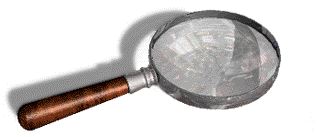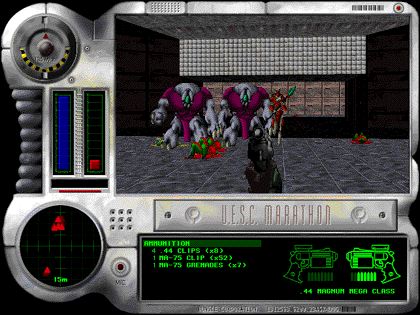

Review: Marathon
by Ross Scott Rubin
Type: First-person texture-mapped shooter
Publisher: Bungie Software (312/563-6200)
Retail Price: $69.99
Street Price: $39.95
Requires: 68020 or faster Macintosh (68040 or faster recommended), 8-bit monitor at 640 X 480, System 6.05 or later (System 7.0 required for networking); 3 MB RAM. 12 MB hard disk, QuickTime 2.0 required for music, Sound Manager 3.0 recommended for sound.
Protection: One-time serial number look-up; network serial number check

According to the Chinese calendar, we are now in the Year of the Pig. But as far as the gaming calendar is concerned, it will be the Year of the First-Person Texture-Mapped Experience. The phenomenal success of 1994's Doom (slated for Mac release later this year), has paved the way for a slew of real-time 3D games. Already, the Mac has started to see the trend with MacPlay's Wolfenstein 3D and Reality Bytes' Sensory Overload. But the company that brought the first of the genre to the Macintosh--1992's smash Pathways into Darkness--has now brought it its best of the genre.
Bungie Software's Marathon is the most sophisticated 3D game for the Macintosh. A wild and often incongruous variety of textures in up to 16-bit color cover its 26 levels of overlapping pathways, elevator platforms, and vast arena-like rooms. In addition to being able to look in any horizontal direction, you can look (and aim) up and down. The requirement of accurate aiming adds significant realism and difficulty to Marathon as does active panning stereo sound, which can indicate sound from the appropriate direction if you have external speakers.
Marathon includes the auto-mapping feature Bungie pioneered in Pathways Into Darkness. While you can zoom in and out on the map and even navigate the byzantine levels in this view, it is often difficult to see more than a small portion even at the smallest magnification. We'd like to see a way to scroll the active area without having to move there. Another peeve is the way Marathon handles saving games, which requires that you reach specific points in the game. Furthermore, double-clicking on a saved game launches Marathon but does not open the saved game. Taken together, these conventions are almost as unMaclike as games that require you to save into slots. In addition, while Marathon can record space-efficient "movies" of its games that play back full-speed, we'd like to see a method to converting these to QuickTime, so that they might be shared with others who don't own the game.
Phfor on the Floor. To fight the Phfor aliens, you can take advantage of a wide variety of weapons including a simple pistol, a machine gun/grenade launcher, a flame thrower, fusion gun (also with two settings), and the incomparable SPNKR-X17 rocket launcher. Unlike in id Software's Doom, you'll really have to work to get the more advanced weapons. The grenade launcher does triple duty. In addition to handily reducing aliens to goop soup, it can remotely trigger buttons and switches, and you can even take advantage of the recoil it generates to lift you up small ledges.
In addition, several chips you'll encounter throughout the game grant special powers. Such as temporary near-invincibility, partial invisibility, an enhanced field of vision and "infrared" (blue actually) vision that allows you to easily point out friends and enemies before blowing them up.

Marathon's multifarious meanies exhibit limited artificial intelligence. These wonderfully strange aliens range from hulks who can throw you across the room to giant poison-spitting moths; all create an endless source of gun fodder. They can wait in the wings to ambush you and follow you around. While we can accept that Phfor are aggressive warriors, though, it seems ridiculous that beings of any intelligence would stand in a line waiting to be slaughtered when the opponent has superior firepower.
Marathon can be played over a LocalTalk or Ethernet network, but ARA compatibility has been put on hold for a future version. For those who can amass up to eight people on the LAN, Marathon may be the best things to happen to Macintosh networking since PhoneNet connectors. Unquestionably, its support of the microphone for sending threats and other missives over the net is a hottest use ever for the Apple microphone. Marathon rewards networked victors through a versatile carnage report that gives statistics and ranks for each player. Indeed, we wish such feedback was available for levels in the one-player version.
Phfor the Better. Bungie has refocused the interface considerably from its Pathways effort. Marathon has only one window, which can't be placed in the background. The borders of the screen show gauges for shield and oxygen level, weapon and ammo status, and a clever motion sensor that proves helpful without spilling all the beans. Marathon's "active" play area takes the lion's share of the screen, but reducing the screen area is one of the several considerations Bungie has included for maximizing game speed on many Macs.
Be forewarned, though, that even the fastest PowerMac will not render speeds comparable to Doom's, partly because of Marathon's higher resolution, but also because of delimiters Bungie has placed in the game. Marathon can be played at full-screen for those who have the Power Macintoshes to take advantage of that feature. Unfortunately, unlike many of its competitors, it removes all of the helpful indicators, including the critical motion detector, even on screens large enough to accommodate these extras without sacrificing play area.
While Marathon retains some of the puzzle-solving aspects of Pathways, and includes many scenarios where progressing depends on your dexterity, it doesn't suffer from the latter's identity's crisis. Pathways talked like a mindless shoot 'em up but played more like an adventure game. That's not to say that Marathon is mindless. While battling an alien invasion, you discover that one of the ship's artificial intelligences, Durandal, has gone "rampant", a cybernetic psychosis that makes 2001's HAL seem about as threatening as your average pocket calculator.
Over the course of the game, you visit terminals with messages from Durandal or Leela, the "good witch" AI who tries to guide you along missions to repel the aliens. One unfortunate aspect of the terminals is that they are completely non-interactive, a bit of an anachronism in such a futuristic scheme. Still, the clues they provide keep the story moving. You'll also encounter special types of aliens called compilers who, by the way, can float up levels to peg you and turn invisible. After they have interfaced with a terminal, you'll encounter what's usually a stream of nonsensical information, but there is sometimes a useful hint or two is to be found even here.
The Finish Line. With excellent support for Macintosh technology that even Apple seems to have forgotten, breakthrough advancement for its genre, excellent performance on Power Macintoshes, an involving story line, elaborate level design, and superb network action, Marathon takes its place as the finest action games ever for the Macintosh and, for the moment, one of the most intense games for any computer platform.
Pros
Cons